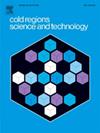变暖导致的基底冰层减弱是冰崩发生的关键原因
IF 3.8
2区 工程技术
Q1 ENGINEERING, CIVIL
引用次数: 0
摘要
越来越多的研究人员开始关注气候变暖和频繁的冰崩事件之间的关系。以往的研究表明,冰岩混合碎屑(IRM)通常分布在高山冰川和基岩之间的接触带。然而,基岩冰混合层在变暖条件下力学特性的变化模式及其对冰崩的贡献尚未得到充分认识。通过控温三轴试验和数值模拟,研究了变温条件下基底冰层的力学行为及其对IA事件的影响。研究表明,从冻结环境到解冻环境(- 8°C到2°C), IRM的变形模式发生了显著变化,IRM的脆性和残余强度下降。此外,在−2℃~ 0.5℃期间,IRM的黏聚力和摩擦角急剧下降,衰减速率分别为72.2 kPa/℃和3.1℃/℃,明显快于其在冰冻环境中的衰减速率。我们认为,变暖导致的IRM强度降低破坏了IA源区的力平衡,因为基底层被剥夺了在冻结状态下对冰川滑动的抵抗力。此外,我们的数值研究揭示了IA启动过程中基底冰层的应力演化过程和损伤模式。这些分析有助于更好地理解气候变暖背景下基底冰层减弱在IA激活中所起的作用。本文章由计算机程序翻译,如有差异,请以英文原文为准。
Warming-driven weakening of basal ice layer as a critical cause of ice avalanche activation
Increasingly, researchers are beginning to focus on the correlation between climate warming and frequent ice avalanche (IA) events. Previous studies have revealed that mixtures of ice and rock debris (IRM) are commonly distributed in contact zones between alpine glaciers and bedrock. However, the changing mode of mechanical characteristics of basal ice-rock mixed layer in warming conditions and its contribution to ice avalanche has not been fully appreciated. Using the temperature-controlled triaxial test and numerical modeling, we investigated the mechanical behavior of the basal ice layer under changing temperature conditions and its contribution to IA events. Our research indicates that the IRM deformation mode changed significantly from freezing to thawing environment (−8 °C to 2 °C), accompanied by decreased IRM brittleness and residual strength. Furthermore, the cohesion and friction angle of IRM drop off rapidly during around −2 °C to 0.5 °C, with rates of 72.2 kPa/°C and 3.1°/°C respectively, noticeably faster than their decay rate in a frozen environment. We suggest that warming-induced reductions in IRM strength disrupt the force balance in the IA source zone, as the basal ice layer is deprived of the resistance to glacial sliding that it provides in a frozen condition. Furthermore, our numerical investigation reveals the stress evolution process and damage pattern of the basal ice layer during IA initiation. These analyses contribute to a better understanding of the role played by the weakening of the basal ice layer in IA activation in the context of climate warming.
求助全文
通过发布文献求助,成功后即可免费获取论文全文。
去求助
来源期刊

Cold Regions Science and Technology
工程技术-地球科学综合
CiteScore
7.40
自引率
12.20%
发文量
209
审稿时长
4.9 months
期刊介绍:
Cold Regions Science and Technology is an international journal dealing with the science and technical problems of cold environments in both the polar regions and more temperate locations. It includes fundamental aspects of cryospheric sciences which have applications for cold regions problems as well as engineering topics which relate to the cryosphere.
Emphasis is given to applied science with broad coverage of the physical and mechanical aspects of ice (including glaciers and sea ice), snow and snow avalanches, ice-water systems, ice-bonded soils and permafrost.
Relevant aspects of Earth science, materials science, offshore and river ice engineering are also of primary interest. These include icing of ships and structures as well as trafficability in cold environments. Technological advances for cold regions in research, development, and engineering practice are relevant to the journal. Theoretical papers must include a detailed discussion of the potential application of the theory to address cold regions problems. The journal serves a wide range of specialists, providing a medium for interdisciplinary communication and a convenient source of reference.
 求助内容:
求助内容: 应助结果提醒方式:
应助结果提醒方式:


